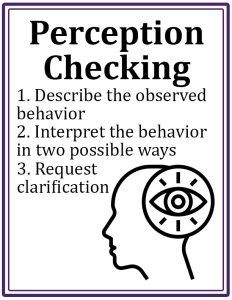2.4 Improving Perception
Learning Objectives
- Discuss strategies for improving self-perception.
- Discuss strategies for improving perception of others.
So far, we have learned about the perception process and how we perceive others and ourselves. Now we will turn to a discussion of how to improve our perception. Our self-perception can be improved by becoming aware of how schema, socializing forces, self-fulfilling prophecies, and negative patterns of thinking can distort our ability to describe and evaluate ourselves. How we perceive others can be improved by developing better listening and empathetic skills, becoming aware of stereotypes and prejudice, developing self-awareness through self-reflection, and engaging in perception checking.
Improving Self-Perception
Our self-perceptions can and do change. Recall that we have an overall self-concept and self-esteem that are relatively stable, and we also have context-specific self-perceptions. Context-specific self-perceptions vary depending on the person with whom we are interacting, our emotional state, and the subject matter being discussed. Becoming aware of the process of self-perception and the various components of our self-concept (which you have already started to do by studying this chapter) will help you understand and improve your self-perceptions.
Since self-concept and self-esteem are so subjective and personal, it would be inaccurate to say that someone’s self-concept is “right” or “wrong.” Instead, we can identify negative and positive aspects of self-perceptions as well as discuss common barriers to forming accurate and positive self-perceptions. We can also identify common patterns that people experience that interfere with their ability to monitor, understand, and change their self-perceptions. Changing your overall self-concept or self-esteem is not an easy task given that these are overall reflections on who we are and how we judge ourselves that are constructed over many interactions. A variety of life-changing events can relatively quickly alter our self-perceptions. Think of how your view of self changed when you moved from high school to college. Similarly, other people’s self-perceptions likely change when they enter into a committed relationship, have a child, make a geographic move, or start a new job.

Aside from experiencing life-changing events, we can make slower changes to our self-perceptions with concerted efforts aimed at becoming more competent communicators through self-monitoring and reflection. As you actively try to change your self-perceptions, do not be surprised if you encounter some resistance from significant others. Remember, people try to increase predictability and decrease uncertainty within personal relationships. For example, many students begin to take their college education more seriously during their junior and senior years. As these students begin to change their self-concept to include the role of “serious student preparing to graduate and enter the professional world,” they likely have friends that want to maintain the “semiserious student who doesn’t exert much consistent effort and prefers partying to studying” role that used to be a shared characteristic of both students’ self-concepts. As the first student’s behavior changes to accommodate this new aspect of his or her self-concept, it may upset the friend who was used to weeknights spent hanging out rather than studying. Let’s now discuss some suggestions to help avoid common barriers to accurate and positive self-perceptions and patterns of behavior that perpetuate negative self-perception cycles.
Avoid Reliance on Rigid Schema
As we learned earlier, schemata are sets of information based on cognitive and experiential knowledge that guide our interaction. We rely on schemata almost constantly to help us make sense of the world around us. Sometimes schemata become so familiar that we use them as scripts, which prompts mindless communication and can lead us to overlook new information that may need to be incorporated into the schema. So it’s important to remain mindful of new or contradictory information that may warrant revision of a schema. Being mindful is difficult, however, especially since we often unconsciously rely on schemata. Think about how when you’re driving a familiar route you sometimes fall under “highway hypnosis.” Despite all the advanced psychomotor skills needed to drive, such as braking, turning, and adjusting to other drivers, we can pull into a familiar driveway or parking lot having driven the whole way on autopilot. But have you slipped into autopilot on a familiar route only to remember that you are actually going somewhere else after you’ve already missed your turn? This example illustrates the importance of keeping our schemata flexible and avoiding mindless communication.
Be Critical of Socializing Forces
We learned earlier that family, friends, sociocultural norms, and the media are just some of the socializing forces that influence our thinking and therefore influence our self-perception. These powerful forces serve positive functions but can also set into motion negative patterns of self-perception. Two examples can illustrate the possibility for people to critique and resist socializing forces in order to improve their self-perception. The first deals with physical appearance and notions of health, and the second deals with cultural identities and discrimination.

We have already discussed how the media presents us with narrow and often unrealistic standards for attractiveness. Even though most of us know that these standards don’t represent what is normal or natural for the human body, we internalize these ideals, which results in various problems ranging from eating disorders, to depression, to poor self-esteem. A relatively overlooked but controversial and interesting movement that has emerged partially in response to these narrow representations of the body is the fat acceptance movement. The fat acceptance movement has been around for more than thirty years, but it has more recently gotten public attention due to celebrities like Oprah Winfrey and Kirstie Alley, who after years of publicly struggling with weight issues have embraced a view that weight does not necessarily correspond to health. Many people have found inspiration in that message and have decided that being healthy and strong is more important than being thin (Katz, 2009). The “Healthy at Every Size” movement and the National Association to Advance Fat Acceptance have challenged the narrative put out by the thirty-billion-dollar-a-year weight-loss industry that fat equals lazy, ugly, and unhealthy (“About Us,” NAAFA: the National Association to Advance Fat Acceptance, accessed July 7, 2023, http://www.naafa.org).
Cultural influences related to identities and difference can also lead to distorted self-perceptions, especially for people who occupy marginalized or oppressed identities. While perception research has often been used to support the notion that individuals who are subjected to discrimination, like racial and ethnic minorities, are likely to have low self-esteem because they internalize negative societal views, this is not always the case (Armenta & Hunt, 2009). In fact, even some early perception research showed that minorities do not just passively accept the negative views society places on them. Instead, they actively try to maintain favorable self-perceptions in the face of discriminatory attitudes. Numerous studies have shown that people in groups that are the targets of discrimination may identify with their in-group more because of this threat, which may actually help them maintain psychological well-being. In short, they reject the negative evaluations of the out-group and find refuge and support in their identification with others who share their marginalized status.
Beware of Self-Fulfilling Prophecies
Self-fulfilling prophecies are thought and action patterns in which a person’s false belief triggers a behavior that makes the initial false belief actually or seemingly come true (Guyll et al., 2010). For example, let’s say a student’s biology lab instructor is a Chinese person who speaks English as a second language. The student falsely believes that the instructor will not be a good teacher because he speaks English with an accent. Because of this belief, the student doesn’t attend class regularly and doesn’t listen actively when she does attend. Because of these behaviors, the student fails the biology lab, which then reinforces her original belief that the instructor wasn’t a good teacher.
Although the concept of self-fulfilling prophecies was originally developed to be applied to social inequality and discrimination, it has since been applied in many other contexts, including interpersonal communication. This research has found that some people are chronically insecure, meaning they are very concerned about being accepted by others but constantly feel that other people will dislike them. This can manifest in relational insecurity, which is again based on feelings of inferiority resulting from social comparison with others perceived to be more secure and superior. Such people often end up reinforcing their belief that others will dislike them because of the behaviors triggered by their irrational belief. Take the following scenario as an example: An insecure person assumes that his date will not like him. During the date he doesn’t engage in much conversation, discloses negative information about himself, and exhibits anxious behaviors. Because of these behaviors, his date forms a negative impression and suggests they not see each other again, reinforcing his original belief that the date wouldn’t like him. The example shows how a pattern of thinking can lead to a pattern of behavior that reinforces the thinking, and so on. Luckily, experimental research shows that self-affirmation techniques can be successfully used to intervene in such self-fulfilling prophecies. Thinking positive thoughts and focusing on personality strengths can stop this negative cycle of thinking and has been shown to have positive effects on academic performance, weight loss, and interpersonal relationships (Stinston et al., 2011).
Create and Maintain Supporting Interpersonal Relationships
Aside from giving yourself affirming messages to help with self-perception, it is important to find interpersonal support. Although most people have at least some supportive relationships, many people also have people in their lives who range from negative to toxic. When people find themselves in negative relational cycles, whether it is with friends, family, or romantic partners, it is difficult to break out of those cycles. But we can all make choices to be around people that will help us be who we want to be and not be around people who hinder our self-progress. This notion can also be taken to the extreme, however. It would not be wise to surround yourself with people who only validate you and do not constructively challenge you, because this too could lead to distorted self-perceptions.
Beware of Distorted Patterns of Thinking and acting

You already know from our discussion of attribution errors that we all have perceptual biases that distort our thinking. Many of these are common, and we often engage in distorted thinking without being conscious of it. Learning about some of the typical negative patterns of thinking and acting may help us acknowledge and intervene in them. One such pattern involves self-esteem and overcompensation.
People with low self-esteem may act in ways that overcompensate for their feelings of low self-worth and other insecurities. Whether it’s the businessman buying his midlife crisis Corvette, the “country boy” adding monster tires to his truck, or the community leader who wears several carats of diamonds everywhere she goes, people often turn to material possessions to try to boost self-esteem. While these purchases may make people feel better in the short term, they may have negative financial effects that can exacerbate negative self-perceptions and lead to interpersonal conflict. People also compensate for self-esteem with their relational choices. A person who is anxious about his career success may surround himself with people who he deems less successful than himself. In this case, being a big fish in a small pond helps some people feel better about themselves when they engage in social comparison.
People can also get into a negative thought and action cycle by setting unrealistic goals and consistently not meeting them. Similar to a self-fulfilling prophecy, people who set unrealistic goals can end up with negative feelings of self-efficacy, which as we learned earlier, can negatively affect self-esteem and self-concept. The goals we set should be challenging but progressive, meaning we work to meet a realistic goal, then increase our expectations and set another goal, and so on.
Some people develop low self-esteem because they lack accurate information about themselves, which may be intentional or unintentional. A person can intentionally try to maintain high self-esteem by ignoring or downplaying negative comments and beliefs and focusing on positive evaluations. While this can be a good thing, it can also lead to a distorted self-concept. There is a middle ground between beating yourself up or dwelling on the negative and ignoring potentially constructive feedback about weaknesses and missing opportunities to grow as a person. Conversely, people who have low self-esteem or negative self-concepts may discount or ignore positive feedback. To wrap up this section, I’d like to turn to one of my favorite shows and a great source for examples relevant to the perception process: American Idol.
I’ve always enjoyed showing clips from American Idol auditions in my class when I teach about self-perception. As you probably know, the season always starts with audition footage shot in various cities. The range of singing abilities, not to mention personalities, of those who show up for a chance to sing in front of the judges leads millions of viewers to keep tuning in.

While it’s obvious that the producers let some people through who they know don’t have a chance at making it on the show, they also know that certain personalities make for good reality television viewing. I’ve often found myself wondering, “Do these people really think they can sing?” The answer is sometimes a very clear “Yes!” Sure, some are there just to make a spectacle and hopefully make it on TV, but there are many who actually believe they have singing abilities—even to the point that they challenge and discount the judges’ comments.
During the contestant’s tearful and/or angry postrejection interview, they are often shown standing with their family and friends, who are also surprised at the judges’ decision. These contestants could potentially avoid this emotional ending by following some of the previous tips. It’s good that they have supportive interpersonal relationships, but people’s parents and friends are a little biased in their feedback, which can lead to a skewed self-concept. These contestants could also set incremental goals. Singing at a local event or even at a karaoke bar might have helped them gain more accurate information about their abilities and led them to realize they didn’t have what it takes to be an “American idol.”
Overcoming Barriers to Perceiving Others
There are many barriers that prevent us from competently perceiving others. While some are more difficult to overcome than others, they can all be addressed by raising our awareness of the influences around us and committing to monitoring, reflecting on, and changing some of our communication habits. Whether it is our lazy listening skills, lack of empathy, or stereotypes and prejudice, various filters and blinders influence how we perceive and respond to others.
Develop Empathetic Listening Skills
As we will learn in Chapter 9: “Listening,” effective listening is not easy, and most of us do not make a concerted effort to overcome common barriers to listening. Our fast-paced lives and cultural values that emphasize speaking over listening sometimes make listening feel like a chore. But we shouldn’t underestimate the power of listening to make someone else feel better and to open our perceptual field to new sources of information. Empathetic listening can also help us expand our self- and social awareness by learning from other people’s experiences and taking on different perspectives. Empathetic listening is challenging because it requires cognitive and emotional investment that goes beyond the learning of a skill set.
I didn’t know what a lazy listener I was until I started teaching and realized how much time and effort teachers have to put into their jobs. Honestly, at first it was challenging to attentively listen to student issues, thoughts, and questions, but I immediately saw the value in it. To be a good teacher, I had to become a better listener. As a result, I also gained more empathy skills and became a lot more patient. A valuable lesson I learned during this time is best stated as follows: “Everyone’s biggest problem is his or her biggest problem.” If one person’s biggest problem is getting enough money together to buy a new cell phone and another person’s biggest problem is getting enough money together to get much needed medication, each of these people is likely experiencing a similar amount of stress. As an outsider, we might look at this example and think about how a cell phone isn’t necessary to live but the medication is. But everyone’s reality is his or her reality, and when you can concede that someone’s reality isn’t like yours and you are OK with that, then you have overcome a significant barrier to becoming more aware of the perception process.
I recently had a good student inform me that he was leaving school to pursue other things. He had given speeches about wildfire firefighting and beer brewing and was passionate about both of those things, but not school. As an academic and lover of and advocate for higher education, I wouldn’t have made that choice for myself or for him. But I am not him, and I can’t assume his perceptions are consistent with mine. I think he was surprised when I said, “I think you are a smart and capable adult, and this is your decision to make, and I respect that. School is not going anywhere, so it’ll be here when you’re ready to come back. In the meantime, I’d be happy to be a reference for any jobs you’re applying for. Just let me know.” I wanted to make it clear that I didn’t perceive him as irresponsible, immature, misguided, or uncommitted. He later told me that he appreciated my reaction that day.
The Watermelon Fable

The Sufis tell a story about a man who was walking down a strange road one day when he came upon a group of terrified villagers fleeing toward him. He stopped the panic-stricken mob to ask them what was the matter, and they cried that there was a monster in the fields. They pointed out into the field, but all the man saw was a watermelon. He turned back to the villagers and, scoffing and sneering, told the ignorant people that there was nothing there but a watermelon. When the villagers insisted that indeed it was a monster, the suddenly wary traveler accused them of lying. The enraged villagers fell upon the man and killed him for being a fool.
A short time later, another, wiser man came down that same road, asked about the trouble, and, following the trembling fingers pointing out to the field, saw only the watermelon. The stranger drew his knife and, with a blood-curdling whoop, ran into the field, leapt upon the watermelon, and hacked it to bits. The villagers were so transported with joy over seeing their enemy destroyed that they made the stranger the leader of their village, a position he retained until it came to pass that he was able to teach them the difference between a monster and a watermelon.
Reflect:
- How does this story relate to the way you communicate with others?
- Can you think of instances in your own life when others could only see “watermelons” when you were looking at “monsters?”
- Can you think of times when you were looking at “watermelons” that others could only see as “monsters?”
- How might this story influence the way you may choose to relate to people with different perceptions in the future?
Beware of Stereotypes and Prejudice
Stereotypes are sets of beliefs that we develop about groups, which we then apply to individuals from that group. Stereotypes are schemata that are taken too far, as they reduce and ignore a person’s individuality and the diversity present within a larger group of people. Stereotypes can be based on cultural identities, physical appearance, behavior, speech, beliefs, and values, among other things, and are often caused by a lack of information about the target person or group (Guyll et al., 2010). Stereotypes can be positive, negative, or neutral, but all run the risk of lowering the quality of our communication.
While the negative effects of stereotypes are pretty straightforward in that they devalue people and prevent us from adapting and revising our schemata, positive stereotypes also have negative consequences. For example, the “model minority” stereotype has been applied to some Asian cultures in the United States. Seemingly positive stereotypes of Asian Americans as hardworking, intelligent, and willing to adapt to “mainstream” culture are not always received as positive and can lead some people within these communities to feel objectified, ignored, or overlooked.
Stereotypes can also lead to double standards that point to larger cultural and social inequalities. There are many more words to describe a sexually active female than a male, and the words used for females are disproportionately negative, while those used for males are more positive. Since stereotypes are generally based on a lack of information, we must take it upon ourselves to gain exposure to new kinds of information and people, which will likely require us to get out of our comfort zones. When we do meet people, we should base the impressions we make on describable behavior rather than inferred or secondhand information. When stereotypes negatively influence our overall feelings and attitudes about a person or group, prejudiced thinking results.
Prejudice is negative feelings or attitudes toward people based on their identity or identities.

Prejudice can have individual or widespread negative effects. At the individual level, a hiring manager may not hire a young man with a physical disability (even though that would be illegal if it were the only reason), which negatively affects that one man. However, if pervasive cultural thinking that people with physical disabilities are mentally deficient leads hiring managers all over the country to make similar decisions, then the prejudice has become a social injustice. In another example, when the disease we know today as AIDS started killing large numbers of people in the early 1980s, response by some health and government officials was influenced by prejudice. Since the disease was primarily affecting gay men, Haitian immigrants, and drug users, the disease was prejudged to be a disease that affected only “deviants” and therefore didn’t get the same level of attention it would have otherwise. It took many years, investment of much money, and education campaigns to help people realize that HIV and AIDS do not prejudge based on race or sexual orientation and can affect any human.
Practice Perception Checking
Because we are never able to fully understand what someone else is thinking, it is important that we deliberately seek out better understanding. We are really good at reading nonverbal cues and interpreting social situations. However, we should never assume that we know the mind of someone else. You can greatly improve your competent communication by practicing a skill called perception checking. The next time you notice someone doing something you don’t fully understand or something you might misread, try perception checking. This requires you to reflect and verbalize your thinking. First, describe the observed behavior, letting the other person know what it is you are seeing. Try to account for both verbal and nonverbal cues. Second, interpret the behavior in two possible ways. You will be explaining to the other person what you think you saw while allowing for the possibility of an alternative interpretation. Finally, ask the other person for clarification. This will allow you to hear their explanation of what you observed. Sometimes one of your two interpretations is correct. Sometimes neither is. As a best practice, you would then refine your perception by restating your improved understanding of the situation.
 There are several really important considerations when practicing this skill. Nonverbal congruency is key. If you approach the other person with an accusatory tone, what you say will not matter because the other person will become defensive. Be sure you are not experiencing emotional flooding such as anger when you attempt to perception check. Wait to cool down and approach with open curiosity and a desire for better understanding. Be sure you complete all three steps in order. Form a perception based on the clues, consider two possible causes, and ask why the person is behaving as they are. Don’t silence the steps. This is about communication and not just improved perception. Many people describe the situation in their heads and think of two possible causes then ask the person in front of them why they did something. While this might be better perception taking, it is not full perception checking. The goal is transparency and openness with the other person, so explain all the thinking. As always, consider the cultural rules of the situation, and the appropriateness of the timing and setting. For example, you might have work scenarios where it is not appropriate for you to be questioning the behavior of clients. A competent communicator will practice new communication skills in appropriate settings and adapt what is valuable to other contexts, as needed.
There are several really important considerations when practicing this skill. Nonverbal congruency is key. If you approach the other person with an accusatory tone, what you say will not matter because the other person will become defensive. Be sure you are not experiencing emotional flooding such as anger when you attempt to perception check. Wait to cool down and approach with open curiosity and a desire for better understanding. Be sure you complete all three steps in order. Form a perception based on the clues, consider two possible causes, and ask why the person is behaving as they are. Don’t silence the steps. This is about communication and not just improved perception. Many people describe the situation in their heads and think of two possible causes then ask the person in front of them why they did something. While this might be better perception taking, it is not full perception checking. The goal is transparency and openness with the other person, so explain all the thinking. As always, consider the cultural rules of the situation, and the appropriateness of the timing and setting. For example, you might have work scenarios where it is not appropriate for you to be questioning the behavior of clients. A competent communicator will practice new communication skills in appropriate settings and adapt what is valuable to other contexts, as needed.
Engage in Self-Reflection
A good way to improve your perceptions and increase your communication competence in general is to engage in self-reflection. If a communication encounter doesn’t go well and you want to know why, your self-reflection will be much more useful if you are aware of and can recount your thoughts and actions.
Self-reflection can also help us increase our cultural awareness. Our thought process regarding culture is often “other focused,” meaning that the culture of the other person or group is what stands out in our perception. However, the old adage “know thyself” is appropriate, as we become more aware of our own culture by better understanding other cultures and perspectives. Developing cultural self-awareness often requires us to get out of our comfort zones. Listening to people who are different from us is a key component of developing self-knowledge. This may be uncomfortable, because our taken-for-granted or deeply held beliefs and values may become less certain when we see the multiple perspectives that exist.
We can also become more aware of how our self-concepts influence how we perceive others. We often hold other people to the standards we hold for ourselves or assume that their self-concept should be consistent with our own. For example, if you consider yourself a neat person and think that sloppiness in your personal appearance would show that you are unmotivated, rude, and lazy, then you are likely to think the same of a person you judge to have a sloppy appearance. So asking questions like “Is my impression based on how this person wants to be, or how I think this person should want to be?” can lead to enlightening moments of self-reflection. Asking questions in general about the perceptions you are making is an integral part of perception checking, which we will discuss next.
Key Takeaways
- We can improve self-perception by avoiding reliance on rigid schemata, thinking critically about socializing institutions, intervening in self-fulfilling prophecies, finding supportive interpersonal networks, and becoming aware of cycles of thinking that distort our self-perception.
- We can improve our perceptions of others by developing empathetic listening skills, becoming aware of stereotypes and prejudice, and engaging in self-reflection.
Exercises
- Which barrier(s) to self-perception do you think present the most challenge to you and why? What can you do to start to overcome these barriers?
- Which barrier(s) to perceiving others do you think present the most challenge to you and why? What can you do to start to overcome these barriers?
- Recount a recent communication encounter in which perception checking may have led to a more positive result. What could you have done differently?
- Think of a story that your family often tells about you. Share that story with a classmate. What does the story say about who you are? Do you agree with this portrayal of yourself? How do you prefer for family members to speak about you?
References
Armenta, B. E. and Jennifer S. Hunt, “Responding to Societal Devaluation: Effects of Perceived Personal and Group Discrimination on the Ethnic Group Identification and Personal Self-Esteem of Latino/Latina Adolescents,” Group Processes and Intergroup Relations 12, no. 1 (2009): 11–12.
Guyll, M., et al., “The Potential Roles of Self-Fulfilling Prophecies, Stigma Consciousness, and Stereotype Threat in Linking Latino/a Ethnicity and Educational Outcomes,” Social Issues 66, no. 1 (2010): 116.
Katz, M., “Tossing Out the Diet and Embracing the Fat,” The New York Times, July 16, 2009, accessed June 6, 2012, http://www.nytimes.com/2009/07/16/health/nutrition/16skin.html.
Stinson, D. A., et al., “Rewriting the Self-Fulfililng Prophecy of Social Rejection: Self-Affirmation Improves Relational Security and Social Behavior up to 2 Months Later,” Psychological Science 20, no. 10 (2011): 2.
A strategy to help us monitor our reactions to and perceptions about people and communication; a skill that helps avoid jumping to conclusions; helps verify the meaning of others’ ambiguous behaviors; includes 3 steps: 1) Description of behavior; 2) Two possible interpretations; and 3) A request for feedback
Units of information, like a stored database, that we use to interpret new experiences
Thought and action patterns in which a person’s false belief triggers a behavior that makes the initial false belief actually or seemingly come true
Set beliefs that we develop about groups that are applied to individuals from that group
Negative feelings or attitudes toward people based on their identity or identities
Being aware of, and able to recount your thoughts and actions

